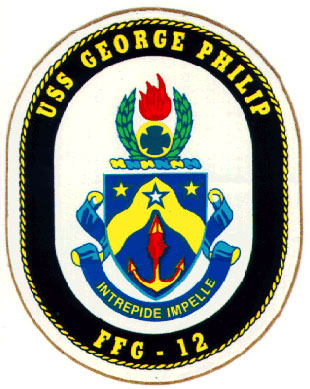Namesake:
Commander George Philip
The USS GEORGE PHILIP, an Oliver Hazard Perry Class guided missile
frigate, is named in honor of Commander George Philip, Jr., USN
(1912-1945).
Commander Philip, born in Fort Pierre, South Dakota, on 14 April 1912,
attended South Dakota School of Mines in Rapid City before his
appointment to the U. S. Naval Academy. After completion of the course
of instruction at the Naval Academy, he was commissioned an Ensign on 6
June 1935. Ensign Philip continued to progress in grade until his
promotion to Commander on 4 September 1944. During this period he
served under a variety of commands including: USS MISSISSIPPI
(1935-37), USS CALIFORNIA (1937-38), USS ELLET (1938-40), USS O'BANNON
(1942-43), and Operational Training Command, Pacific Fleet, San Diego,
California (1943-44). He then served as Commanding Officer of USS
TWIGGS (1944-46).
Commander Philip established a skilled fighting reputation while
simultaneously serving as the Executive Officer, Navigator and Combat
Intelligence Officer of the famed O'BANNON. For his conspicuous
gallantry during the crucial stages of the Soloman Island Campaign,
Philip was awarded the Silver Star Medal and O'BANNON received the
Presidential Unit Citation.
Commander Philip was posthumously awarded the Navy Cross for
extraordinary heroism while commanding TWIGGS during an 84-day period
of combat near Okinawa. He died following a dusk attack by a Japanese
kamikaze aircraft on 16 June 1945.
On 12 March 1946, Secretary of the Navy James Forrestal stated, during
the presentation of the Navy Cross to his widow:
"His courage, fortitude and initiative in the performance of a
difficult and hazardous duty characterized Commander Philip as a
brilliant leader and seaman, reflecting the highest credit upon himself
and the United States Naval Service, he gallantly gave his life in the
service of his country."
In addition to the Navy Cross, Silver Star Medal, and the Presidential
Unit Citation, Commander Philip received the American Defense Service
Medal, and the Purple Heart.
|
Historical Notes:
15 November 1980: USS GEORGE PHILIP
commissioned at Todd Shipyard in San Pedro, California.
November 1980 - June 1981: Sea
trials and testing.
June 1981: Received the Battle "E"
award for excellence.
July 1982 - February 1983: First
deployment in support of USS ENTERPRISE battle group.
September 1984 - March 1985: Second
deployment in support of U. S. efforts to keep sea lanes open in the
Persian Gulf during the height of the Iran-Iraq war.
June 1985: Transfer to the Naval
Reserve Force (NRF). As a member of the NRF, the ship turns its focus
to the training and readiness of Selected Reservists. The ship goes
from full manning to 60% manning, whit the remainder made up of
Reservists.
June 1985 - June 1987: Engineering
and weapons readiness examinations and inspections. Training for
helicopter pilots.
December 1987 - June 1989: Overhaul
at Southwest Marine in San Diego. While in overhaul the ship receives
major upgrades in Anti-Submarine Warfare (ASW) capabilities. The ship
is fitted with a Tactical Towed Array Sonar (TACTASS), widely
recognized as very effective equipment in submarine detection.
June 1989 - May 1992: Extensive ASW
operations and test platform for the new ASW equipment.
May 1992 - August 1992: Third
deployment in support of efforts to counter drug traffic from South
America to the United States.
August 1992 - June 1994: Various
independent operations and port visits that include: San Francisco;
Seattle; Vancouver, British Columbia; and Mazatlan, Mexico.
July 1994 - October 1994: Fourth
deployment in support of efforts to counter drug traffic from South
America to the United States.
October 1994: Escorted towing of
former USS RICHARD B . RUSSELL (SSN 687) to Bremerton Naval Station. |
Ship's Crest:
 The Shield:
Dark blue and gold are
the colors traditionally associated with the Navy and are symbolic of
the sea and excellence. The stars represent three Pacific Island
campaigns -- the liberation of the Philippine Islands; the conquest of
Iwo Jima; and the capture and occupation of Okinawa -- during which
Commander Philip commanded USS TWIGGS (DD-591). The blue star, voided
white, refers to the Silver Star awarded to Commander George Philip,
Jr., for gallantry while serving aboard USS O'BANNON in the Solomon
Islands. The wavy chevron suggests thrust and movement from a strong
base that characterized the Pacific campaigns. The barbed and enflamed
anchor symbolizes naval firepower and alludes to the Navy's progressive
sweep through the Pacific Islands during World War II. It further
typifies the capabilities of guided missile frigates. The Shield:
Dark blue and gold are
the colors traditionally associated with the Navy and are symbolic of
the sea and excellence. The stars represent three Pacific Island
campaigns -- the liberation of the Philippine Islands; the conquest of
Iwo Jima; and the capture and occupation of Okinawa -- during which
Commander Philip commanded USS TWIGGS (DD-591). The blue star, voided
white, refers to the Silver Star awarded to Commander George Philip,
Jr., for gallantry while serving aboard USS O'BANNON in the Solomon
Islands. The wavy chevron suggests thrust and movement from a strong
base that characterized the Pacific campaigns. The barbed and enflamed
anchor symbolizes naval firepower and alludes to the Navy's progressive
sweep through the Pacific Islands during World War II. It further
typifies the capabilities of guided missile frigates.
The Crest: The dark blue screwiest
refers to the Navy Cross posthumously awarded to Commander Philip. He
gave his life when his ship, USS TWIGGS, was damaged from a Japanese
torpedo and kamikaze attack off Okinawa in June 1945. The fire bomb
symbolizes military prowess. The laurel wreath symbolizes the victory
in the Pacific for which Commander Philip gave his life and the great
honor and respect he earned throughout his naval career.
|

